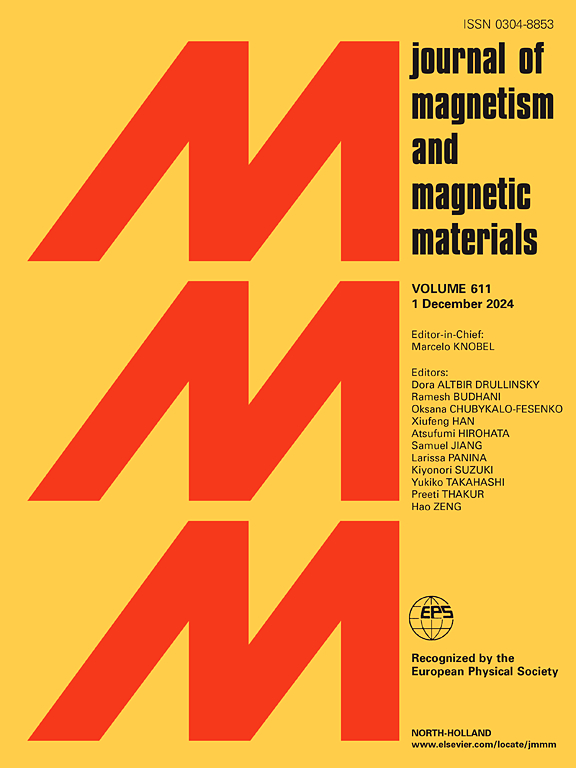限制磁性纳米结构中相稳定性斯基米子图、内部磁构型和磁基米子尺寸的计算预测
IF 2.5
3区 材料科学
Q3 MATERIALS SCIENCE, MULTIDISCIPLINARY
引用次数: 0
摘要
在本文中,我们提出了一项计算研究,利用机器学习(ML)算法预测矩形磁性纳米结构中的相稳定性skyrmions映射,内部磁构型和磁性skyrmions半径。矩形磁性纳米结构的固定长度为128 nm,宽度为56 ~ 128 nm。研究考虑了垂直磁各向异性和Dzyaloshinskii-Moriya相互作用常数的不同值。利用人工神经网络(ann)和生成对抗网络(gan)成功地预测了圆形磁性天空粒子沿z轴的相位稳定性天空粒子图、内部磁化图像和磁化剖面。这些预测通过微磁Mumax3程序的模拟得到了验证,证明了尽管磁相互作用很复杂,但机器学习方法是成功的。这项工作的结果强调了机器学习算法的潜力,通过在很短的时间内准确预测广泛的场景,来推进限制磁性纳米结构中磁天空的研究。本文章由计算机程序翻译,如有差异,请以英文原文为准。
Computational prediction of phase-stability skyrmion maps, internal magnetic configuration, and size of magnetic skyrmions in confined magnetic nanostructures
In this paper, we present a computational study predicting the phase-stability skyrmion maps, internal magnetic configuration, and radii of magnetic skyrmions in rectangular magnetic nanostructures, using machine learning (ML) algorithms. The rectangular magnetic nanostructures have a fixed length of 128 nm and variable widths ranging from 56 and 128 nm. The study considers different values of perpendicular magnetic anisotropy and the Dzyaloshinskii-Moriya interaction constants. Artificial neural networks (ANNs) and Generative Adversarial Networks (GANs) were successfully employed to predict phase-stability skyrmion maps, internal magnetization images, and magnetization profiles along the z-axes for circular magnetic skyrmions. These predictions were validated through simulations using the micromagnetic Mumax3 program, demonstrating the success of the machine learning approach despite the complexity of the magnetic interactions. The results of this work highlight the potential of machine learning algorithms in advancing the study of magnetic skyrmions in confined magnetic nanostructures by accurately predicting a wide range of scenarios in a significant short time.
求助全文
通过发布文献求助,成功后即可免费获取论文全文。
去求助
来源期刊

Journal of Magnetism and Magnetic Materials
物理-材料科学:综合
CiteScore
5.30
自引率
11.10%
发文量
1149
审稿时长
59 days
期刊介绍:
The Journal of Magnetism and Magnetic Materials provides an important forum for the disclosure and discussion of original contributions covering the whole spectrum of topics, from basic magnetism to the technology and applications of magnetic materials. The journal encourages greater interaction between the basic and applied sub-disciplines of magnetism with comprehensive review articles, in addition to full-length contributions. In addition, other categories of contributions are welcome, including Critical Focused issues, Current Perspectives and Outreach to the General Public.
Main Categories:
Full-length articles:
Technically original research documents that report results of value to the communities that comprise the journal audience. The link between chemical, structural and microstructural properties on the one hand and magnetic properties on the other hand are encouraged.
In addition to general topics covering all areas of magnetism and magnetic materials, the full-length articles also include three sub-sections, focusing on Nanomagnetism, Spintronics and Applications.
The sub-section on Nanomagnetism contains articles on magnetic nanoparticles, nanowires, thin films, 2D materials and other nanoscale magnetic materials and their applications.
The sub-section on Spintronics contains articles on magnetoresistance, magnetoimpedance, magneto-optical phenomena, Micro-Electro-Mechanical Systems (MEMS), and other topics related to spin current control and magneto-transport phenomena. The sub-section on Applications display papers that focus on applications of magnetic materials. The applications need to show a connection to magnetism.
Review articles:
Review articles organize, clarify, and summarize existing major works in the areas covered by the Journal and provide comprehensive citations to the full spectrum of relevant literature.
 求助内容:
求助内容: 应助结果提醒方式:
应助结果提醒方式:


